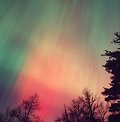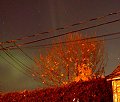|
Summary: A fast-moving coronal
mass ejection
(CME) that raced away from the Sun on Nov. 4th swept past our
planet at 0150 UT on Nov 6th (8:50 p.m.
EST on Nov 5th); the impact
triggered a widespread geomagnetic storm. Sky watchers in many
US states -- including Tennessee, Alabama, the Carolinas, Florida,
Texas and California -- reported vivid red and green auroras.
This
is Page 2 : Click for Page 1 or Page 3
Unless
otherwise stated, all images are copyrighted by the photographers.
|
|
Photographer, Location |
Images |
Comments |
 |
Joe
Minow, Huntsville, Alabama, USA
Nov. 5 |
#1,
#2, #3 |
J. Minow: "This display would have been
excellent on an Alaskan scale for pure red aurora!! Typically
further north you always get some green [OI]557.7 nm emissions
that accompany the red [OI]630.0 nm light. This far south the
red is typically all you see....indicating emissions from altitudes
>300 km." |
 |
Norm Klekoda,
Grand Rapids, MI, USA
Nov. 5 |
#1,
#2, #3,
#4, #5,
#6, #7 |
Photo details: Canon 35mm camera, 28 and 50mm
lens, Fuji 800 film |
 |
Dirk Obudzinski,
near Napa and Lake Berryessa, CA, USA
Nov. 5 |
#1,
#2, #3,
#4 |
D. Obudzinski: "Beautiful red auroras displays
with detailed rays that lasted for about one hour." Photo
details: Nikon EM camera,50mm lens,10 to 20 sec. exposures on
Kodak Royal Gold 400 film |
 |
Ian Cooper,
Glen Oroua, Manawatu, New Zealand
Nov. 6 |
#1,
#2, #3,
#4 |
I. Cooper: "In the shots of Canis Major,
Southern Cross, and Scorpions Tail the auroral activity was sub-visual.
In the Capricorn & Mars shot we could just see the SAR arc
by eye." |
 |
Wade B Clark
Jr, Skagit County, Washington, USA
Nov. 5-6 |
#1,
#2, #3,
#4, #5 |
W. Clark: "The aurora display was beautiful.
The waning gibbous moon and Jupiter added to the mystery of the
scene. The greens and reds were awesome indeed!" Photo details:
28mm f1.8 lens, 10 to 25 second exposures. |
 |
Jesús
Ojeda, St. Francis, WI, USA
Nov. 5 |
#1, #2, #3,
#4, #5,
#6, more |
J. Ojeda: "This was the best display of
the year. By 10:00pm local time they were everywhere in the sky.
What a night!" Photo details: Nikon N80 camera, 28mm lens,
f-stop 3.5, Fuji Superia 800 film, 20-30 second exposures. |
 |
Scott Machalk,
Marquette, Michigan, USA
Nov. 5-6 |
#1,
#2, #3,
#4, #5 |
Photo details: Canon EOS 1N, 28 mm f1.8 lens,
Fuji Provia RDPIII ASA 100, 20 to 30 sec exposures. |
 |
Chris VenHaus,
Waukesha, WI, USA
Nov. 5 |
#1,
more |
Photo details: Canon A2E, Fuji Provia 400F, and
Canon 24mm f2.8 lens for 15 sec |
 |
Todd Cory,
Mt. Shasta, CA, USA
Nov. 5 |
#1,
#2, #3 |
Photo details: Olympus C-700 digital camera,
f=2.8, 16 sec. exp, ISO=800. |
 |
Todd Lindley,
10 miles north of Tulsa, Oklahoma , USA
Nov. 5 |
#1 |
T. Lindley: "This is a panoramic image created
by pasting two standard prints. The rising moon is visible in
the bottom right." Photo details: 8-15 second exposures
at f2.8 28mm lens on Fuji 800 speed film. |
 |
Debbie
Kinloch and Mike Csorbay, near York, Ontario, Canada
Nov. 5-6 |
#1,
#2, #3,
#4, #5,
#6, #7,
#8, more |
D. Kinloch: "This phenomenal display of
very red aurora started around 9:30 p.m. and lasted until around
2:30 in the morning. The corona was visible for nearly the entire
time. Pics taken with a Nikon FE, 15mm f3.5 and 28mm f3.5, 15
to 30 seconds. Films used: Fuji Superia 400, 800, Kodak Max 400,
800 ASA." |
 |
Jimmy
Westlake, Steamboat Springs, Colorado, USA
Nov. 5 |
#1,
#2, #3,
#4, #5,
#6 |
J. Westlake: "The bright moonlight didn't
seem to hinder [things] at all, in fact, I think the moonlight
activated my cones more than usual... these auroras had more
vibrant colors to my naked eye than many I can remember."
Photo details: Kodak Max 400 film, Nikon FE-2, 50 mm lens |
 |
Mike
Schroeder, Rogers, Arkansas, USA
Nov. 5 |
#1,
#2, #3 |
M. Schroeder: "I used an old Sears 35mm
camera on a tripod with ASA-400 film, 50mm lens at f/2.8 and
various exposure times from 10-30 seconds." |
 |
Tom A.
Warner, Rapid City, SD, USA
Nov. 5 |
#1,
more |
T. Warner: "Images were taken using a Nikon
FM2 camera with Fuji Provia 100F slide film. Camera settings
were as follows Shutter: 30 sec - 2 minutes Aperture: f/2.8 Lens:
Nikon 20 mm" |
 |
Mike Lynch,
Frankfort Kentucky, USA
Nov. 5 |
#1,
#2 |
M. Lynch: "I was looking for Comet LINEAR
(C/2000 WM1) with binoculars when I suddenly noticed the northern
sky was a DEEP red. The fisheye-lens photo, showing my sky from
West to East, has the Moon hidden behind a utility pole. The
bright Moon didn't wash out this very bright auroral display." |
 |
Gary Sumner,
Grass Valley, CA, USA
Nov. 5 |
#1,
#2, #3 |
G. Sumner: "Many calls were made to 911
as observers thought there was a very large forest fire." |
 |
Robb Heinz,
Mason City, Iowa, USA
Nov. 5 |
#1,
#2 |
Photo details: Nikon FM, ISO 400, 50mm, f2.8
and exposures lasting about 15-20 seconds |
 |
Philippe
Moussette, Cap-Rouge Québec, Canada
Nov. 5 |
#1,
#2 |
Photo details: Coolpix 995 digital camera, 15
second exposures, 400ASA |
 |
Robert
Smith, Stoneville, NC, USA
Nov. 5 |
#1,
#2, #3 |
Photo details: 9-11 PM EST, Lens: 28mm f 2.8,
Film: Fujicolor 200 Super HQ |
 |
Daphne
Zaras, near Norman, Oklahoma, USA
Nov. 5 |
#1,
#2, more |
D. Zaras: "Both photos were taken with a
Canon Elan SLR camera with 50 mm fixed focus lens set at f22
(yes, I know - I meant to have it set at f1.8 but in the excitement
of seeing aurora in Oklahoma I forgotten I'd set it differently
last time I used the camera!!). The film was Kodak Royal Gold
400 ASA." |
 |
Mike O'Leary,
50 miles east of San Diego, CA, USA
Nov. 5 |
#1,
#2 |
M. O'Leary: "These photos were taken from
Sunrise Highway in the Laguna mountains. The camera was an OM-1
with a 24mm lens at f/2.0. Exposures were one minute using Fuji
Provia 400F film." |
See
also our Oct. 28, 2001, aurora gallery!
back
to spaceweather.com |



















